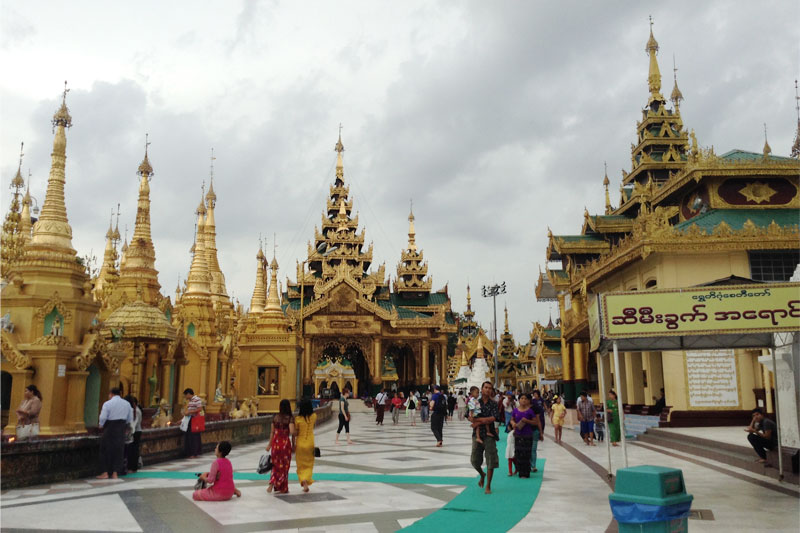Shwedagon by day and by night

Devotees flock to the complex on Singuttara Hill.
MANILA, Philippines - It shines by the day, with the sun as its very own spotlight. It illuminates at night amidst a blanket of the moon and shining stars, complimented by flood lights. The star is the Shwedagon Pagoda, also referred to as the Great Dagon Pagoda or the Golden Pagoda. Its overpowering presence may be seen, no matter where you are, throughout the city of Yangon.
Situated on Singuttara Hill, this golden stupa grandly rests on a rectangular raised enclosure which occupies several city blocks. At a staggering 326 feet, it may well be the first and the last sight you see each day.
The whole complex is open on all four sides, with elevators and ramps for people with disabilities. Everyone is truly welcome here, as long as you follow the strict dress code (knees and shoulders should be covered) and go barefoot (socks are not allowed), since this is not just a tourist attraction but an active place of worship.
According to local legend, the site, erected more than 2,600 years ago, cements itself as the oldest Buddhist venue in the world. It is said that two merchant brothers met the Lord Gautama Buddha, and upon receipt of his personal items, sought a place to store them.
The imposing religious structure is considered the most sacred Buddhist place of worship in Myanmar, as it is believed to host the relics of four Buddhas. These artifacts are the eight hair strands from Gautama, and from those who have preceded him, such as the staff of Kakusandha, the water filter of Konagamana and the robe piece of Kassapa.
We made our way to the area of the main pagoda, with its sturdy brick base, covered with golden plates. Right above it are terraces, accessible only by monks. I looked in admiration at the intricate details, and these are what I could see: the central part was made to look like a bell, and on top of it were what seemed to be artistic patterns of a turban. A bowl with inverted arms and upright lotus petals followed, then the banana-bud designs. It is capped off with the 43-foot tall umbrella crown covered in 500 kilos of gold plating. Over 80,000 jewels are said to be part of the pagoda, including nearly 5,500 diamonds.
It is important to note, though, that it is misleading that the area is known just as the Shwedagon Pagoda – for it offers more than just this golden stupa.
The rest of the complex features several eye-catching sights. Smaller East Asian style towers may be appreciated throughout the vast landscape. These include the Naungdawgyi Pagoda, Hitdaw Pagoda and a replica of the Shwedagon Pagoda. Various images of Buddha are likewise strategically positioned, together with the Bells of King Singu and Tharyarwady situated on opposite sides.
Our knowledgeable guide shared that Burmese Vedic astrology recognizes the seven universally known bodies, which are the Sun, Moon, Mercury, Venus, Mars, Jupiter and Saturn, with the additional heavenly formations known as Rahu and Ketu. Interestingly, the local townsfolk know the ins and outs of their days of birth, and have a certain reverence for the various days of the week, which they call their planetary post. Their passion is similar to people’s obsession with the zodiac and the lunar signs.
In fact, they have a dedicated octagonal altar for each day of the week. And believe it or not, they have appropriated two slots for Wednesday – the day of my birth – the morning and the afternoon. This is because Wednesday is Rahu’s Day from 6 p.m. to midnight, hence the split.
Each of the eight platforms is marked by a certain animal – garuda, tiger, lion, mouse, guinea pig, elephants tusked and tuskless and the naga, a deity in the shape of a great snake. A statue of the Buddha rests above, with devotees pouring water on the sculpture as they whispered their invocations and intercessions.
All around were independent sellers of blooms, candles and incense, colored flags and streamers, placed at the worship sites as a symbol of the act of giving, an integral aspect of their belief.
But neon lights in surrounding kiosks fought for my attention, which included some active money changing counters, and even puppet shows for the curious.
Families, friends and lone individuals casually sat around, sans chairs and stools, to meditate, pray and self-examine, enveloped by the feeling of peace and tranquillity.
We chanced upon a mother with her son, training to be a monk. According to the mom, she knew he would be there, so she dropped by for a surprise reunion.
We likewise noticed volunteer lady sweepers, who did their job in earnest and unison, all in a row, followed by two equally devoted men who swept the bits the women may have missed.
In addition to the main sights within the compound, there are approximately a dozen showrooms ranging from interesting museums and extensive photo galleries to stone inscriptions and Bodhi trees. The Boetaw Thikyar and a statue of a child clutching Brahma may also be seen up close.
After having spent the day at the religious center of the city, there was really no escaping the enriching spiritual experience, for before I retired for the day, I could still see the bright glow of the Shwedagon Pagoda from the hotel veranda. Photos by Edu JARQUE



















